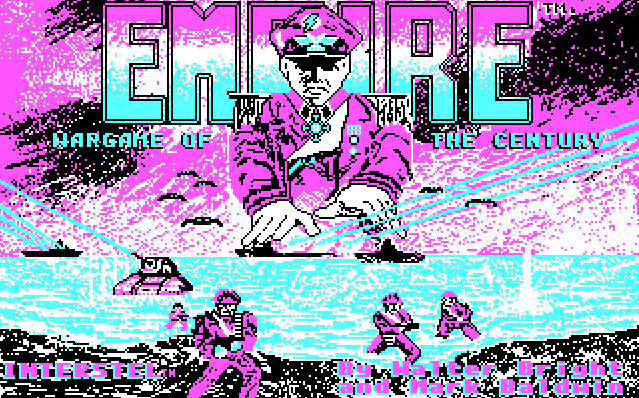
“The past was alterable. The past never had been altered. Scythia was at war with Nabatea. Scythia had always been at war with Nabatea.”
I covered on this blog the great precursors of computer wargames, but I am missing three: three unrelated wargames in 1972, 1973 and 1977 all confusingly called Empire, which all started on mainframe before being ported on personal computers.
- The 1972 Empire was coded by Peter Langston on the Evergreen college HP2000. It is a multiplayer 4X game where you manage all sorts of resources in order to build more units and expand, in some ways an ancestor in spirit to Civilization but also to strategy browser games. Various iterations have survived until early 2010, but the game seems to be in its final throes.
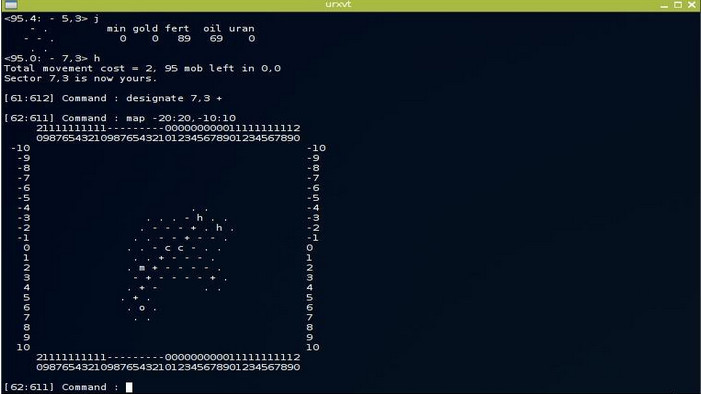
- The 1973 Empire on PLATO branched into two very different games, for added complexity:
- Empire I, later Conquest, is a real-time multiplayer space strategy game,
- Empire II and its successors (creatively called Empire III and Empire IV) are real-time multiplayer space combat with a strategic layer.
The Data Driven Gamer heroically tried to cover Empire I and Empire III, and then Empire IV. It is worth a read.

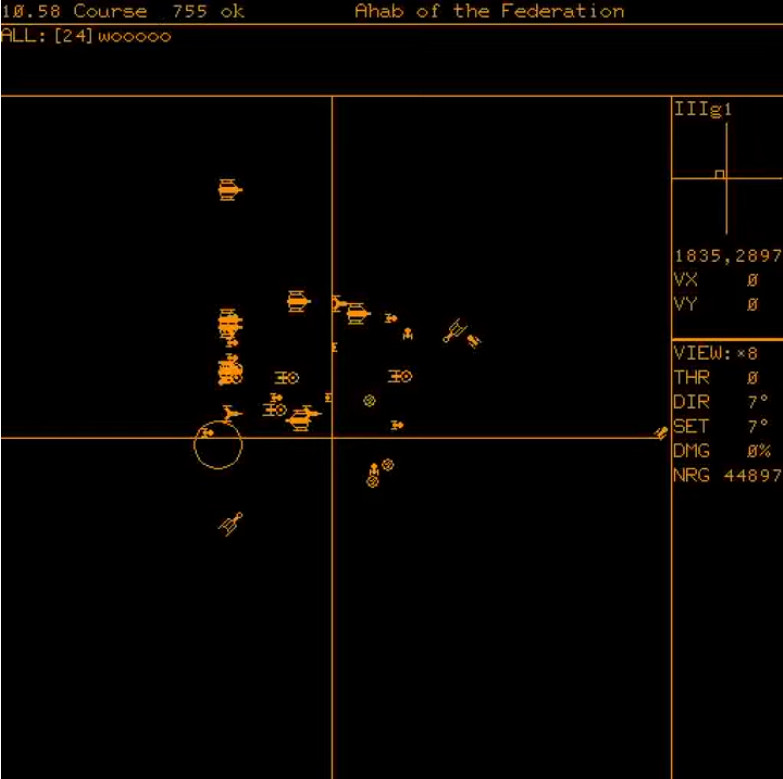
- Finally, the 1977 Empire is the one I will cover today. It was coded by Walter Bright (helped by several friends) on PDP-10 at Caltech.
There are other games called Empire, in particular a series of RPGs, but only two other eponymous games (a 1984 game for BBC Micro and a 1985 French game for Amstrad CPC) are possibly within the scope of this blog, so let’s ignore these for now.
So back to the 1977 Empire. Walter Bright tells the story of the game here. The game was successful at Caltech, but Bright moved to other projects. Unbeknownst to him, some people had managed to obtain his Empire source code, and after some Star Trek-style chains of modifications the game ended up being published in the Digital Equipment Computer User’s Society (DECUS) catalogue, possibly around 1979; sadly I cannot check exactly when as the DECUS archives are not online. In any case, Walter Bright later convinced the DECUS that he was the original author, and he was properly credited starting in 1983.
Unlike Star Trek, Empire started slow on personal computers. The first recorded version was ported by Walter Bright on… Heathkit H-11, a 1978 PC I had never heard about. Bright announced the new game in Byte magazine in April 1983 and managed to sell exactly two copies.
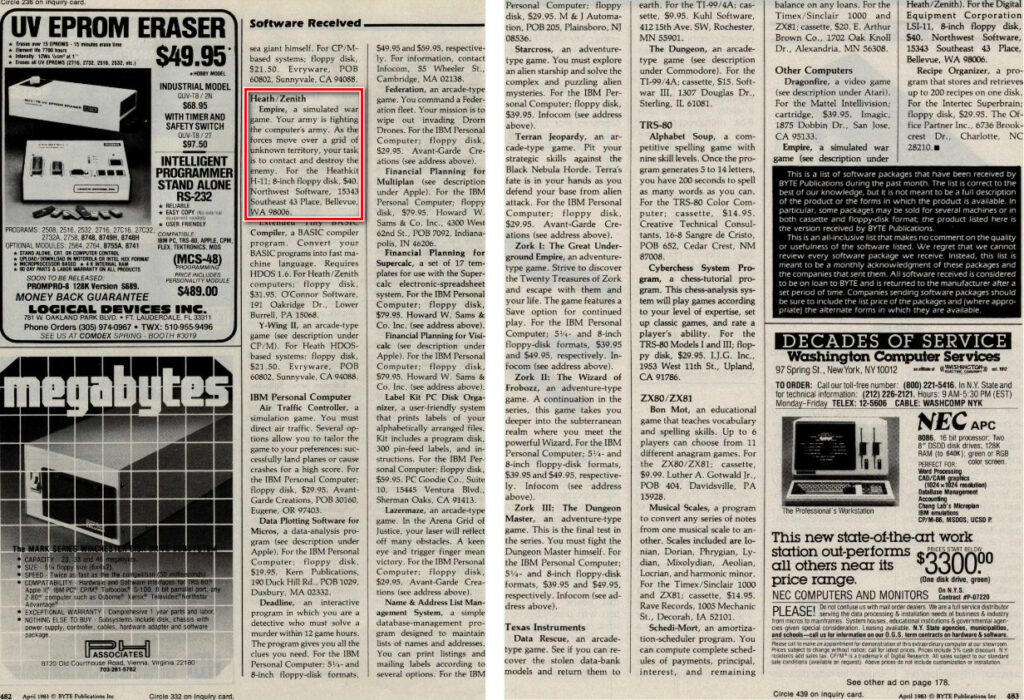
Bright realized he needed to work on more popular systems, and he immediately started to code the game for the third time, in C for IBM PC. He announced this version in Byte in January 1984 and this time Empire – now with colour – sold very well. Not a moment too soon, as unauthorized shareware versions started to circulate that year (and possibly as early as late 1983).

Surprised by the success of the game, Bright looked for publishers. After losing some time in a licensing to Epyx that petered out, he found only one: Intelsoft. He licensed his game, Mark Baldwin (not yet famous for The Perfect General) coded it, and in 1987 Intelsoft released Empire : Wargame of the Century.
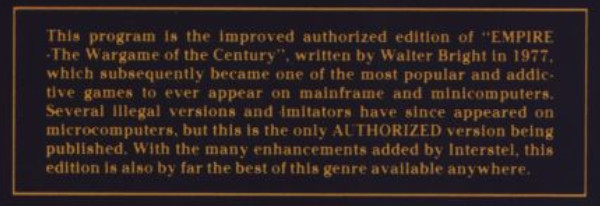
Unlike Star Trek, the game did not die out in the late 80s. Empire continued receiving upgrades (for instance from New World Computing for the 1993 Empire Deluxe), and up to this day : there was an Empire Deluxe Combined Edition released on Steam in 2018.
For this AAR, I will use the 1987 version for several reasons :
- You can set-up games with rules very close to the original iteration of Empire,
- It is not in ASCII but has a graphical tileset, which will be easier for everyone involved,
- The Data Driven Gamer already covered a 1984 (or 1983?) no-graphics version,

As I set my game, I try to emulate as much as possible the original version :
- Only 1 opponent (the 1987 version allows up to 2)
- “Standard AI”, the Expert one is new ,
- No production or combat bonus for anyone,

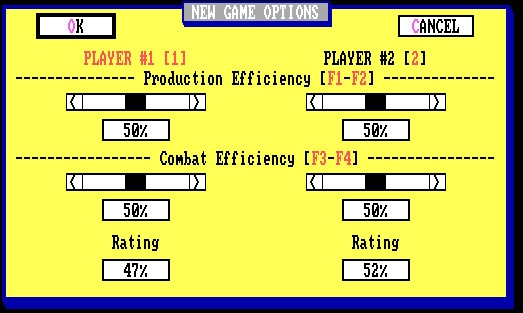
- And of course, random world map !
Insular beginnings
I take control of the Scythian civilization, with the city of Meeanee under my control and very little idea about the general situation. The game asks me what I want to build. The only sensible choices are armies – armies are the only units that can conquer cities – and fighters that are excellent scouts.

I build one fighter, which takes 12 turns (all automatically passed). I then switch to building armies.
My first air patrols don’t find any city, but the landmass expands West, so that’s where my armies are going.

Finally, a city ! Note that my plane also found an island-city East, but without transport, it is out of reach.

In Empire, neutral cities don’t produce anything – they are just there waiting to be conquered. Armies only have 50% of chance of winning against a city. I am lucky, and conquer the city. It is called Little Big Horn.

I start building transports to hop from island to island. Little Big Horn is also used as a new airbase for my fighters. Fighters can move by 5 tiles every turn, but they can only stay in the air for 4 turns – and they can only land in a friendly city or an aircraft carrier.
Shortly after that, I find the city of Minden. It is also conquered easily. As it is inland, I use it to build armies, and Meeanee starts building transports.

In the South, I find one last city on my initial landmass : Eylau. I lost 5 armies so far trying to take it, and it is still not under my control. Meanwhile, I also explore a very interesting island in the West.

Shortly thereafter, I encounter an enemy plane ! The dreaded Nabateans ! There is no discussion with those people. They are our enemies ! Always have been, even before I encountered them ! I attack them, but my fighter is shot down.
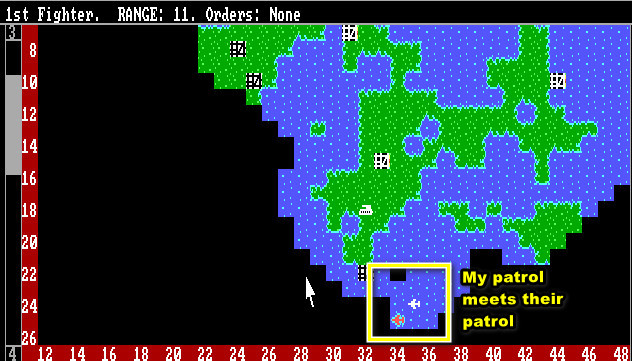
Archipelago expansion
My transports are built, the problem is that Eylau in the South swallowed all my armies – seven in total now – and it is still “neutral”, so now all my cities are building armies.
Soon enough, I can load some of those new troops in my transports :

A few turns later, I finally take Eylau. I am also lucky in that I easily conquer footholds on the islands left and right, and from those footholds I build more armies.

With 8 cities, I start to build a more diversified military power : planes and destroyers on my main island, armies to expand on the new islands. They are slow to build though : 24 turns !
I have a bit of a surprise a few turns later : an enemy transport is spotted by my plane as it returns from patrol !

The transport is destroyed, but it had the time to drop an army, which takes Minden !
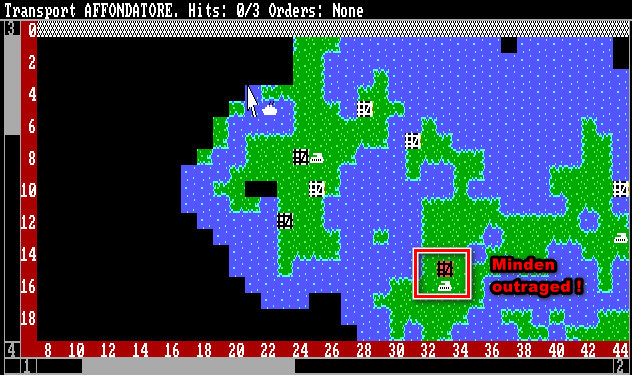
Happily enough, my army almost immediately retakes it. Still, close call.
By turn 100, this is the Scythian Empire. At this point, I stopped trying to remember the names of most of my cities.
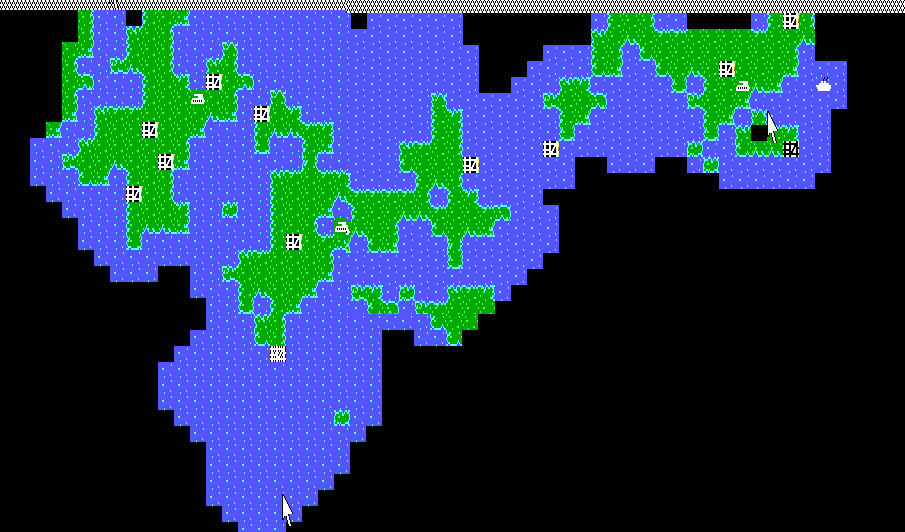
It is large, but the world is much larger still :

And few turns later, I find some of the squalid Nabatean cities ! No wonder the Nabatean flew over my landmass, they were very close indeed.
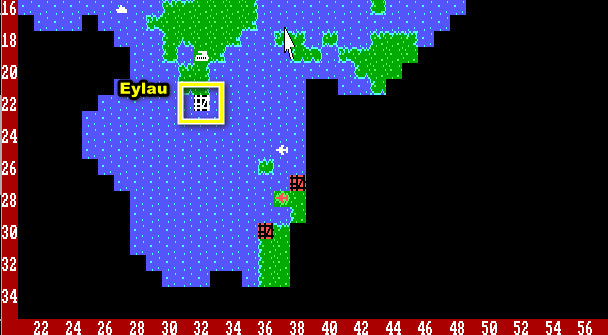
My plane destroys no fewer than 3 armies before being shot down. The era of, er, “peaceful” expansion is over.
War across the channel
I expand left and right with transport and armies, but most of my airplanes are reallocated to Eylau, the city closest to the Nabateans, curse be on their name.
There are frequent air combats above the sea or next to Eylau, and luck is against me – I lose more planes than they do. Eventually, my vile enemy tries another landing :
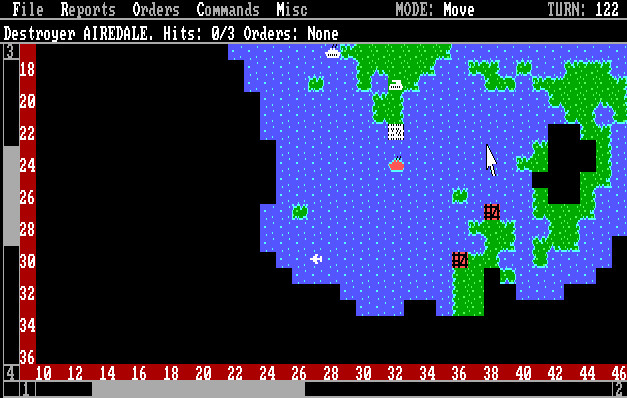
Sadly, my fighter is destroyed as it attacks the transport, and Eylau is captured.
Not for long though ! A few turns later, a transport I had earmarked for an attack is nearby. My first destroyers also arrive on the scene, they will intercept further enemy reinforcements.

Eylau falls back under my control. After this setback, the tide starts to turn. My destroyers intercept two transports in the channel separating my blessed Empire and their accursed land. One more transport is sighted and destroyed much more to the East.
It is my turn to attack their cities. Escorted by destroyers and my planes, one of my transports manages to land a couple armies, and set up a foothold : the formerly Nabatean city of Dominica !
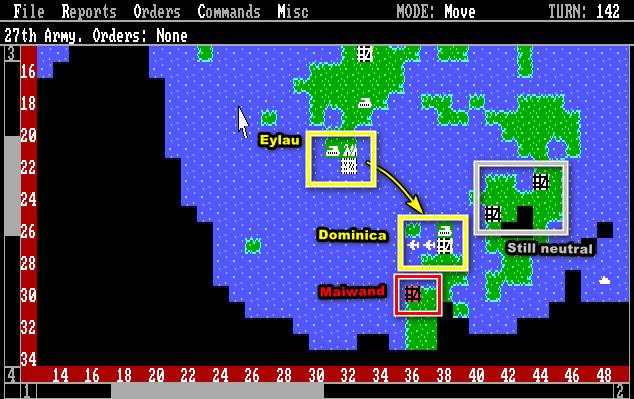
With Dominica as my new airbase, I push South, and take Maiwand :

This is the situation by turn 150 :
- World Map

- Forces :

You may wonder how long it takes to manage all those armies, fleets and planes every turn. Actually, it is incredibly fast for a 1987 game : you can give go to/patrol orders to all your units, and automate “flight paths” for your planes – any plane in a city with an outgoing flight path will automatically fly to the next destination.

This “quality of life” feature was apparently already present in some of the earliest iterations of Empire.
The pursuit
I have the advantage, I am pushing strongly. I quickly conquer two more enemy cities, including one on a different island !
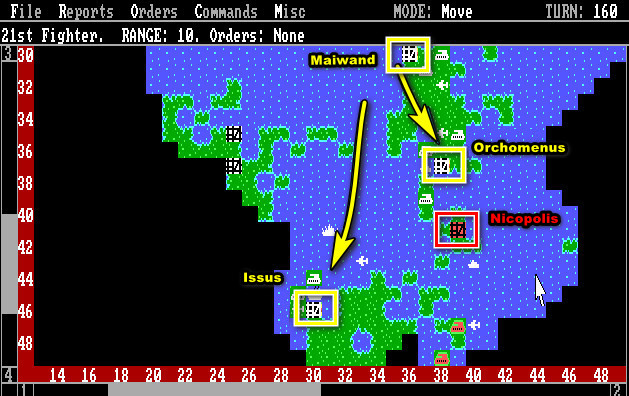
I pursue the enemy South, where I encounter a lot of enemy armies :
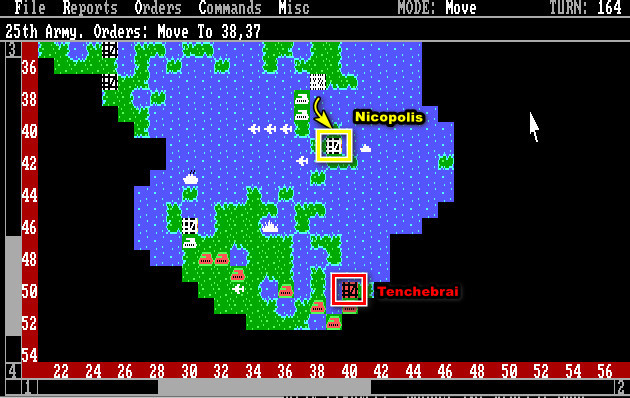
But I now have a battleship in the area. Battleships can bombard armies from the shore, and while they can be damaged doing so, they have 12 HP, and I can repair them in ports. The battleship and my horde of fighters clean up the island pretty quickly.
And eventually, all the island is mine !

But the war is not over. There are more enemies in the East !
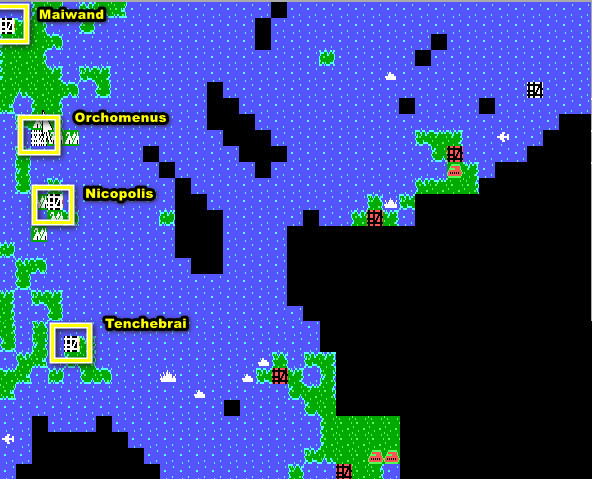
I manage to land some transport, barely as enemy fighters harassed my transports. There are a lot of enemies, but my repaired battleship solves that problem, too.
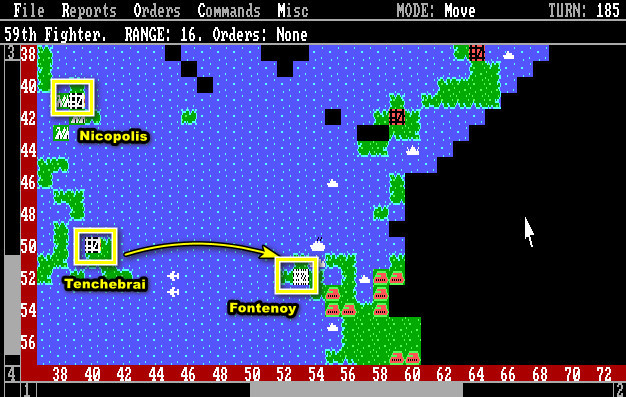
I reach turn 200. At this point, the enemy has 3 cities left, including one in the South that it defends vigorously !
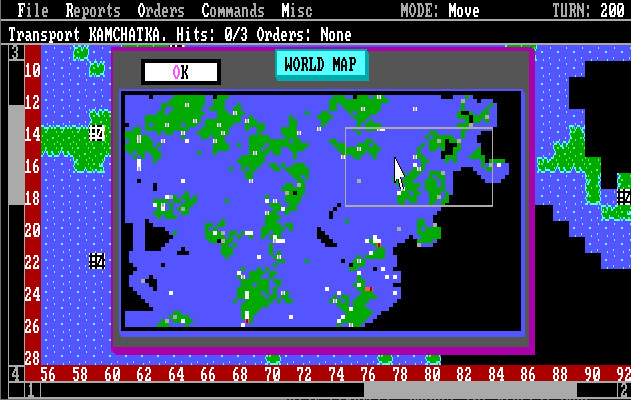
I have so many units, so much production that the game is now slow and boring – it has been since turn 160 at least. I clearly won, but the game won’t stop.
I order most of the newly produced units to sleep. More than half the planes I lost are planes I did not bother bringing to an airport as their fuel ran out.
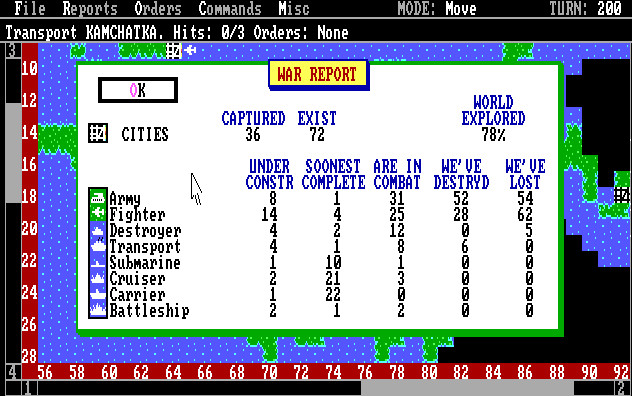
After 11 more gruesome turns, I finally surround the last city :

It is taken ! I am thankful it is over. The map is not even fully explored. Imagine if they had properly colonized that huge chunk I am still missing !

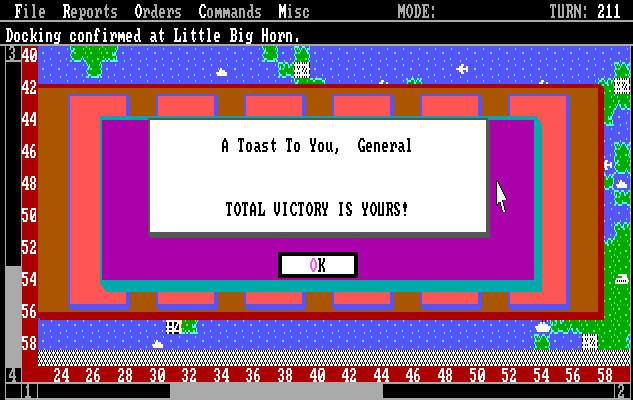
Rating and Reviews
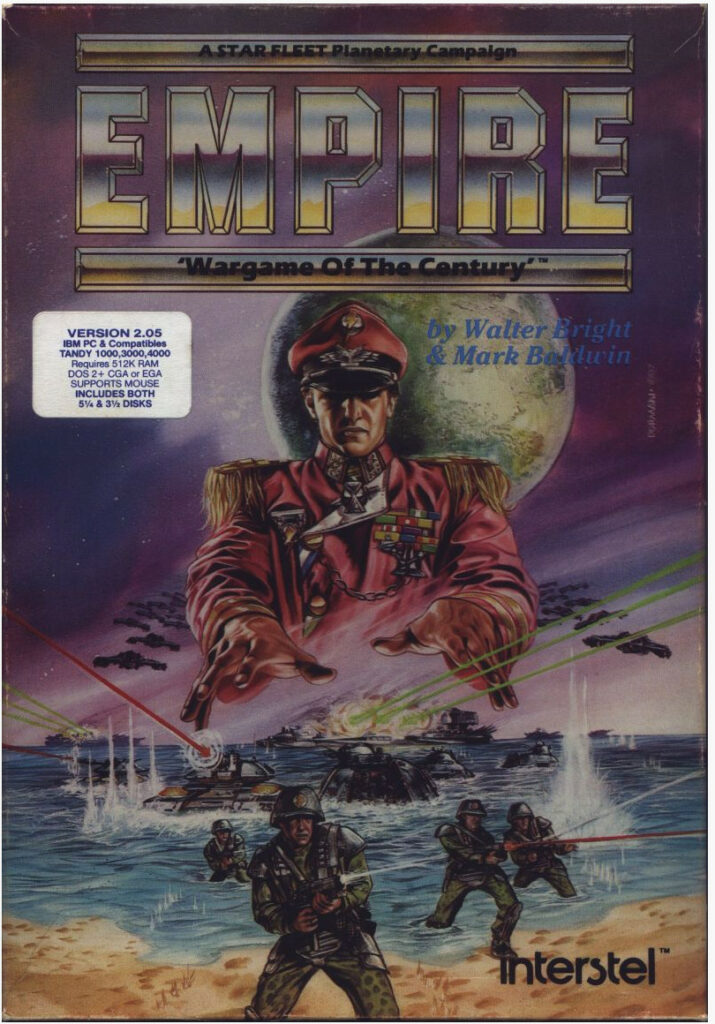
Empire, by Walter Bright and a bunch of his friends.
First release : 1977 on PDP10
Tested on : DosBox,1987 version
Total Hours Tested : 5 hours
Average duration of a battle : 2 hours if you win “quickly”. A lot more if you don’t.
Difficulty: Easy (1/5)
Would recommend to a modern player : Not 1987 or earlier versions
Would recommend to a designer : Yes
Final Rating: Obsolete
Except when stated otherwise, my review is on the 1987 version.
A. Immersion
There are two narratives in Empire, Wargame of the Century. The first one is the one the game tells you about : Empire is the second opus of the Star Fleet saga. What is Star Fleet you ask ?
Well, yes, obviously, Star Fleet I is a Star Trek game, though not really a clone ; it has a lot more options and, also, you are not fighting Klingons but instead – let me check – Krellans. Star Fleet also has no relationship with Walter Bright, but had been published by Interstel in 1985, and sometimes, when you are a small publisher, you really want to create your own license.

In Star Fleet‘s Empire, Wargame of the Century, the United Galactic Alliance is trying to stop the Krellan alliance from subduing worlds by, well, subduing the worlds themselves – but listen they are the good guys OK ? To do this, both the United Galactic Alliance and the Krellan Alliance take control of random local civilizations, in my case the Scythians and the Nabateans, but the list of available civilizations is pretty long.
So this is the Intelsoft narrative.
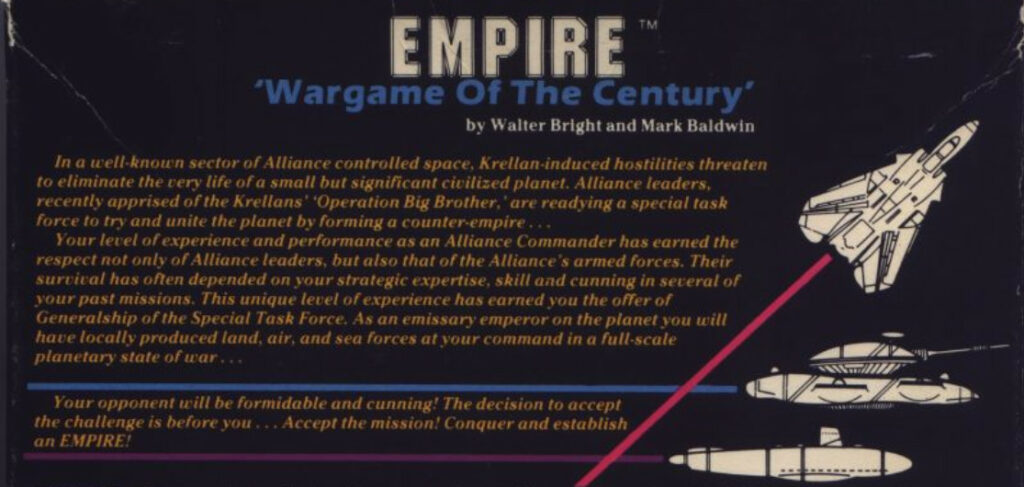
The second narrative, and for that matter the narrative of every other Empire game, is that you are an ambitious civilization trying to conquer the world using WW2 or so technologies.
Guess which narrative everyone remembers?
In any case, in the 1987 version, the name of the cities is a puzzling choice : they are all named for famous (or not) battles. Taking the city of Little Big Horn or even Austerlitz is weird. Earlier versions don’t give names to the cities.
The game has functional graphics (but not really great for a 1987 game), limited sound effects but also music – it plays Grieg’s “Hall of the Mountain King“, horribly off-pitch in MS-DOS, but pretty nice on Amiga.
Rating : Mediocre
B. UI , Clarity of rules and outcomes
Starting with the bad : I find scrolling in this game pretty difficult. You need to drag a sluggish slider. This makes navigating the map quite difficult – harder than in the much older Eastern Front 1941 for instance. Selecting units in cities is not easy – I am not quite sure how to activate units in sleep mode when in cities, to the extent that I made my units sleep outside my cities, which in turn disturbed my flight path as the planes did not know how to get around those units, and then some of my planes crashed. Oh well, easy come, easy go, I had won already when this happened.
That said, the game is doing a lot of things right. The player can manage dozens of units incredibly fast thanks to a wide array of commands : flight path, go to, patrol, delay, escort, … Mid-game turns take less than 20 seconds to play, and the game only slowed down at the end because it was managing so many planes going through their flight path until the final destination, where they would all just settle in for the Big Sleep…
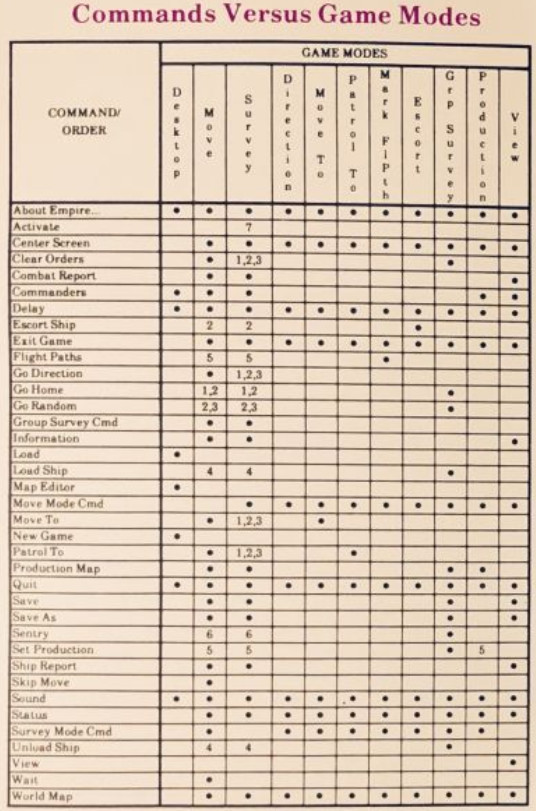
Rating : Very good
C . Systems
The ruleset is incredibly simple, which gives the game its strength. Cities produce units at a standard speed – and nothing else. The first unit takes 20% more time to produce than the next one, you need to pay that extra cost every time you change unit type.
With a few exceptions (transport, carriers), in combat a unit has 50% chance to deal one damage during each attack, and 50% chance to receive one damage – units fight until there is only one left. Armies and planes have only 1 HP, battleships have 12 and everything else is in between.

There are a few extra rules here and there :
- cruisers and battleships can attack ground units (armies can always attack naval units),
- submarines are hard to see,
- planes need to land every 4 turns,
- carriers and transports lose 2 in carrying capacity for each damage received,
- ships slow down as they get damaged, but can be repaired in ports (1HP/turn)
And that’s all. A very simple game.
The rules have not changed much since the original version, with only a few balancing changes :
- the addition of bombardment,
- fighters could fly 5 turns before, but with a speed of 4 only,
- and of course, the impact of having a third player.
There are other quality of life changes though : in particular you cannot attack your own units, nor can you send your armies into the sea or ships into the group (destroying them) anymore.
Overall, the game feels like a Civilization where you don’t need to bother with research, economy or diplomacy. It works really well as a ruleset, the problem is in the scenario design.
Rating : Excellent
D. Scenario design & Balancing
Empire, Wargame of the Century offers random maps, predesigned maps and a scenario editor.
Let’s start with the random (which is what you had to use in any earlier version) : you cannot choose the size of the maps, and in my opinion at 98×58 they are quite simply too big. The AI is weak : it does not manage island hopping well, builds too many armies compared to ships and ignores easy nearby neutral targets as it sends unescorted transports on long journeys. As for playing hundreds of turns of that game with a friend in hotseat, I don’t think anyone except young siblings would have that kind of time.
I played two full games, once against normal AI, once against Expert AI – in both cases my empire kept growing after meeting the AI, while the AI didn’t expand.
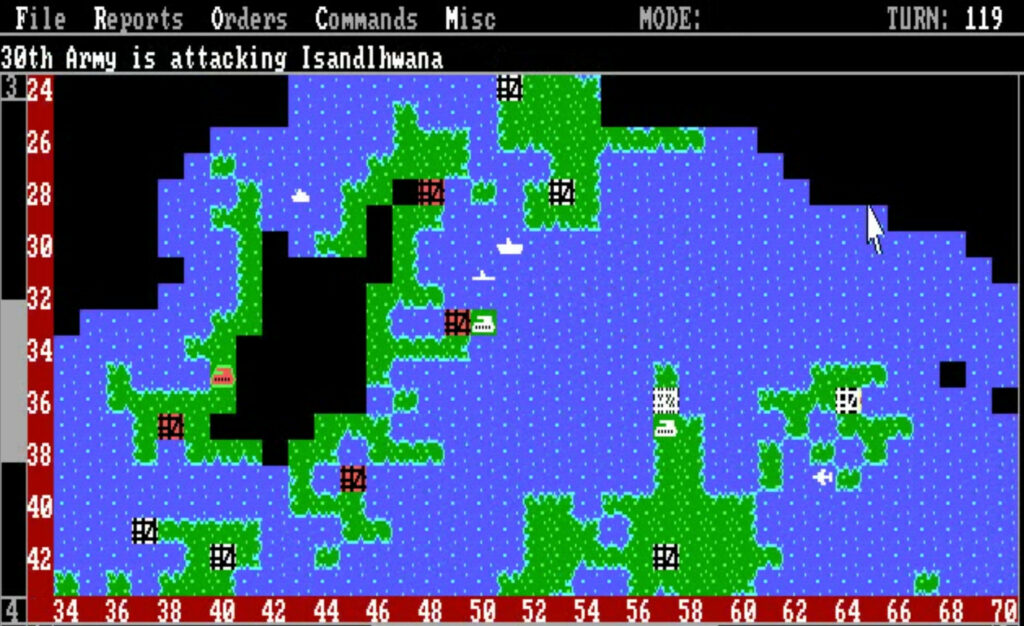
So you quickly have a decisive advantage over the AI and know you are going to win, but the world is so large that the game continues long after victory is obvious. Of course, in the 1987 edition you can give the AI a flat production or attack bonus, and certainly it would make that tense moment longer… but the grind after that will be all the more tedious.
The predesigned maps look nice, they are a mix of well-balanced maps, “special” maps (eg no landmass) and “real” maps (Caribbean, Mediterranean and South-East Asia). I have not played them, but presumably they have the same problem, as they are exactly as large as the standard maps.
Finally, the map designer theoretically allows you to create smaller maps, but only using the center of the world and having everything else occupied by ocean tiles… but the AI would not know this, and would probably send its transports blindly across the endless ocean.
The game would have been awesome if you could have created smaller maps, or scenario of sorts where you and the AI start with a few cities already. As it is, the game is a boring expansion through neutral cities at the beginning, then a few tense turns when you first meet the AI, and then a loooooong chore where you know you have won but you need to land on all those islands and hope that the Random Number Generator let you take those cities.
Rating : Very poor, which is really sad given how good the ruleset is.
E. Did I make interesting decisions ?
Not many. The game all the prerequisites, but it is just too easy. You make a few optimization choices in the beginning and a few tactical decisions when you first meet the enemy, but once you take the advantage – and it will happen fast – the game is just drudgery until the final screen.
F. Final rating
Obsolete. The game is certainly the first strategy computer wargame (Star Trek and Tanktics are tactical games) and it was tremendously influential, but even its 1987 version did not age well- the fun-to-length ratio is just not good enough.
Still, I am looking forward to play the later post-1987 Empire games.
Contemporary Reviews
Empire encountered an immense and lasting success. True, before 1987, the only coverage I could find of Empire for PC is in Creative Computing in September 1984. The review is short but positive, concluding “for strategists who delight in organizing and running military campaigns, Empire proves that the glory that was the mainframe continues on the microcomputer”.
The release of Empire, Wargame of the Century puts the game at the forefront of gamers’ attention. Compute! reviews the game in March 1988 and the reviewer (Neil Randall) starts by stating that the marketing blurb warning the user about the addictiveness of the game was, for once, not an exaggeration. “The warning may be worth heeding”. Randall praises the interface and explains why the game “truly rewards strategy“ and then concludes “Strategy gamers should find nothing to dislike here, Empire contains one of the best interfaces I’ve seen on any complex game, and its design foundation is strong. […] This is a superb, addictive game.”
Jerry Pournelle in Byte Magazine (January 1989) testifies he had a similar experience. In a weird article on portable computers, he goes on a tangent on game design, and covers this “fascinating war game” : Empire. He mocks the “fairly silly scenario shell” trying to force the game into the Star Fleet universe. “All of that is about as silly as the game’s box cover: a drawing of an overdressed chap who looks to be under 20 and has enough gold braid and medals to make any generalissimo proud.” But then covers the warning about the risk of addiction : “The odd part is that they’re right, Empire is an addictive game.” Amazing Computer Magazine in December 1988 triples-down on the addictiveness of the game, also calling it “perhaps one, if not THE, greatest computer game ever written.“
These are all great reviews, but no publication put Empire as high on a pedestal as Computer Gaming World. In the January 1988 issue of Computer Gaming World, William Kritzen explains the game in detail and gives “Ten Commandments” to be a good player. He then concludes “if there was an 11th Commandment, it would be : Buy this game. It is addictive, a tough challenge, and […] fun to play !”
Empire then starts appearing on CGW’s list of best wargames, taking the second place in March 1988 then the first in April – where it remains for the rest of the year (earning it Game of the Year status). It slides to third position early 1989, and then disappears from the list altogether in May 1989… because such is the fate of games that ascend to CGW’s coveted Hall of Fame !
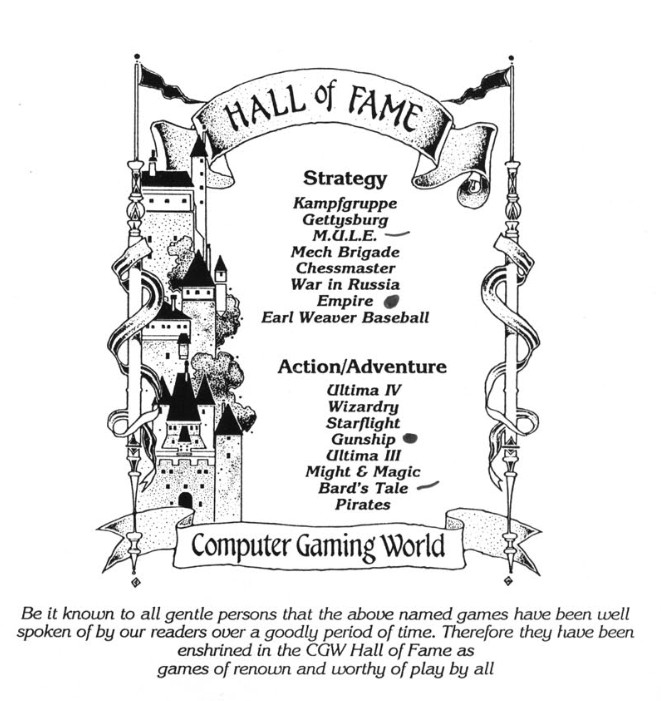
Its presence in the Hall of Fame of course does not prevent the readership from rating the game very highly – in January 1990, more than two years after its release it is still first with 220 points, the challenger being Dungeon Master with 183 points. CGW also includes Empire in its 1991 retrospective of wargames, calling it a post-WWI simulation (presumably making some Krellans cry) and giving it 4 stars and half. Empire’s star finally faded in 1993 and it received only 3 stars in a new retrospective… probably because Empire Deluxe had been released, earning 4 stars. Still, in 1996, CGW ranked Empire 8th “best game of all time”, right between Wing Commander and Wasteland ; its spiritual sequel Civilization was 1st.
If I ever reach 1993, I will play Empire Deluxe – the game seems to fix everything I complained about in the 1987 edition. Meanwhile, while I believe the “Wargame of the Century” edition did not age well, I accept that it is is a strong contender for “Wargame of the 1980s” … but first I need to play to several hundred more wargames to confirm this !
On an unrelated note, I will be doing another Commenters Command for a still secret game, so you can register until Monday.
Article edited on 24/10/2021 to remove an incorrect claim that the 1972 Empire was Sid Meier’s inspiration for Civilization. Meier was inspired by the 1977 Empire indeed !
Edited on 05/12/2021 as I realized Empire was ranked 8th best game of all time in 1996 by CGW